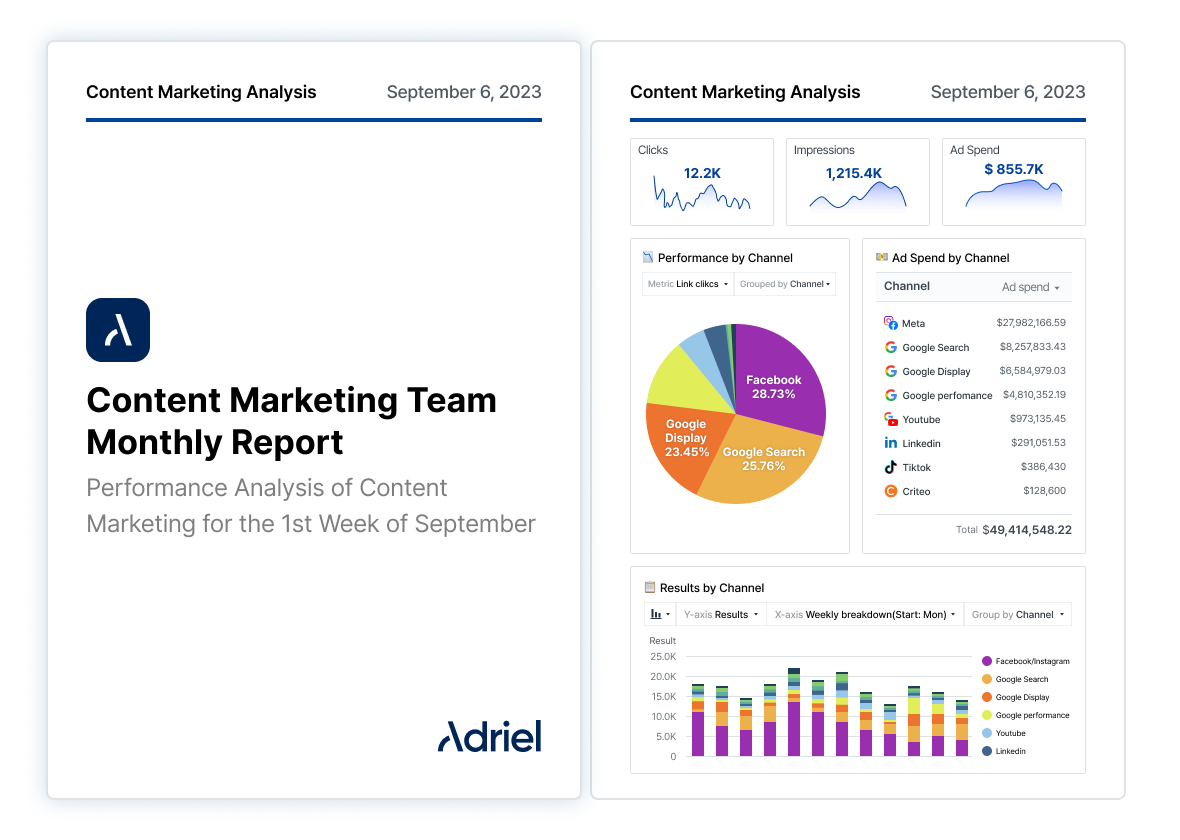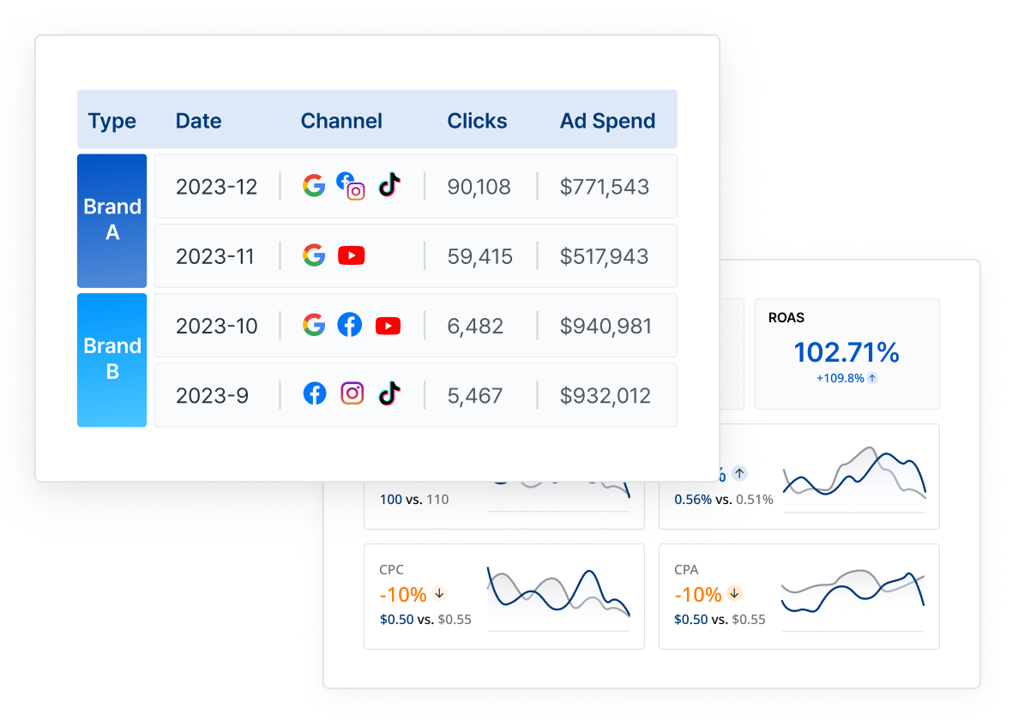Refer a partner and get paid! Earn 20% of all qualifying subscriptions referred to our team 👉

Learn More
Aggregate and visualize your ad data and GA4 data on one dashboard.
Get unique insights into the customer journey of your target audience, and make data-driven decisions.



A GA4 and ad performance dashboard is a custom report for mapping ad performance data from PPC campaigns and GA4 website data. This is a great digital marketing tool for marketing agencies and CMOs with multichannel ad campaigns who wish to understand better about the customer journey.
On Adriel, you get a comprehensive view of your most important metrics on one platform. Generate realtime reports for your C-suite or clients with your own branding or your clients’. Analyze ad creatives and find out which ad copy, image, emoji, and CTA works better for conversions.
Creating an ads performance report and mapping it with your GA4 data is as easy as 1-2-3 with Adriel. Just connect your ad accounts and marketing channels from a drop-down menu and your data will start flowing onto the dashboard automatically. No coding or technical knowledge required.

Sign up for Adriel with your email after your demo.
You can then select a pricing plan that suits your needs.

Simply choose from a drop-down list to import dimensions and metrics from your client’s ad accounts, analytics tools, and mobile measurement partners.
Adriel supports integrations with up to 650+ data sources, including social media channels, ad platforms, analytics tools, and eCommerce platforms.
And if you don’t see an integration that we support natively, we can create custom integrations just for you.

Use our ready-made templates to instantly see all your KPIs in minutes.
Or, start from a blank page and choose your data visualization widgets and graph types.

Set up different views for each account manager or client in just a few clicks. Give different access permissions and collaborate with others on a live dashboard.

Automate your entire client reporting process. Determine your clients’ brand visuals, colors, and logos, and download fully customized reports as PDFs or CSVs. Or share links to the live dashboard with clients.
An ad performance and GA4 report should visualize essential metrics
and provide insights into your website and paid media campaigns.




Ad revenue is the income generated from your ad campaigns. It is a critical KPI for assessing the profitability and return of your advertising efforts.
ROAS evaluates the revenue earned for every dollar spent on advertising, crucial for determining the financial success of your ad investments.
Link clicks are the number of times users have clicked on a link within your ad. They signify user interest and are essential for understanding which content drives interaction.


Ad Spend tracks the total expenditure on your advertising campaigns. Monitoring this helps in maintaining budget control and calculating the cost-effectiveness of your ads.
Cost per click measures the cost for each click on your ad. This metric is crucial for managing the budget and optimizing the cost-efficiency of your ad spend.
Click through rate measures the effectiveness of an ad by the percentage of viewers who click on it, indicating how compelling your ad is to your audience.


Impressions count how often your ad is displayed, reflecting the reach of your campaign. Tracking impressions helps gauge brand awareness and the frequency of ad exposure to your audience.


Impressions count how often your ad is displayed, reflecting the reach of your campaign. Tracking impressions helps gauge brand awareness and the frequency of ad exposure to your audience.


Total Users refers to the number of distinct website visitors in a specific period of time. It helps you know how many unique visitors you're attracting.


Sessions measure the number of times people have visited your website. A person can visit multiple times, and each visit counts as a session.


Pit conversions against total ad interactions to get conversion rates. Compare your conversion rates against any other metric, such as ad spend, to better understand your marketing performance.


The conversion rate indicates the percentage of visitors who complete a desired action, like a purchase, sign-up, or download. It's a direct measure of your campaign's success in motivating users to take action.




When reporting Meta Ads, you will want to visualize Instagram Ads and Facebook Ads performance side-by-side to understand how each platform is contributing to your digital marketing goals. Here’s how it looks like on Adriel’s report template:





Integrate all your paid ad channels’ results into one marketing reporting dashboard. Curious to know how your Meta, Google, or TikTok Ads are performing? Connect all of these platforms to Adriel, and in less than 5 minutes, show all of your paid campaign results in one unified dashboard. See our integrations page for more information.


Our software was expertly designed with powerful functions for marketers. But everything can be customized. Adriel’s flexibility allows you to change all aspects of the dashboard design and appearance. Impress your clients with a professional marketing reporting dashboard report for an expert brand image.
You can start from a blank page to create a marketing reporting dashboard, but what if you don’t have time? Our extensive pre-made marketing reporting dashboard library has everything you might need. Try Adriel, and you’ll have more time to research ways to increase conversion or optimize your landing pages.













.png)

Yes, you can. But it can be very complex and time-intensive, often involving intricate steps and a deep understanding of marketing analytics. Marketing agencies and brands we’ve talked to say they needed to hire an external consultant to set up a GA4 dashboard.
Marketing dashboards like Adriel can save you hours on visualizing key metrics–without needing to re-learn Google Analytics 4 or build custom dashboards yourself.
On Adriel, you can not only build an accurate and stunning dashboard in minutes, but also map out your website data with paid media data like Google Ads. It’s 100% code-free, incredibly easy to use and shows real-time data.

GA4 brings significant changes compared to its predecessor, Universal Analytics, primarily through its shift from a session-based to an event tracking model. Now, every user interaction, not just clicks or form submissions, are treated as events, offering a more holistic view of user behavior.
Another critical change lies in the expanded options for attribution models in Google Analytics 4, so marketers can enjoy more flexibility and precision in analyzing the impact of different marketing channels.
If you’d like to dig deeper into
Check out this blog post.

Creating a Google Ads report is super easy on Adriel. Just:
